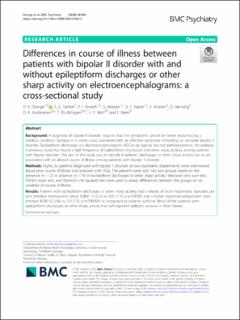| dc.contributor.author | Drange, Ole Kristian | |
| dc.contributor.author | Sæther, Sverre Georg | |
| dc.contributor.author | Finseth, Per Ivar | |
| dc.contributor.author | Morken, Gunnar | |
| dc.contributor.author | Vaaler, Arne | |
| dc.contributor.author | Arntsen, Vibeke | |
| dc.contributor.author | Henning, Oliver Johannes | |
| dc.contributor.author | Andreassen, Ole Andreas | |
| dc.contributor.author | Elvsåshagen, Torbjørn | |
| dc.contributor.author | Malt, Ulrik Fredrik | |
| dc.contributor.author | Bøen, Erlend | |
| dc.date.accessioned | 2020-12-08T10:53:35Z | |
| dc.date.available | 2020-12-08T10:53:35Z | |
| dc.date.created | 2020-12-07T16:46:42Z | |
| dc.date.issued | 2020 | |
| dc.identifier.citation | BMC Psychiatry. 2020, 20, . | en_US |
| dc.identifier.issn | 1471-244X | |
| dc.identifier.uri | https://hdl.handle.net/11250/2712363 | |
| dc.description.abstract | Background
A diagnosis of bipolar II disorder requires that the symptoms cannot be better explained by a medical condition. Epilepsy is in some cases associated with an affective syndrome mimicking an unstable bipolar II disorder. Epileptiform discharges on electroencephalograms (EEGs) are typical, but not pathognomonic, for epilepsy. A previous study has found a high frequency of epileptiform discharges and other sharp activity among patients with bipolar disorder. The aim of the study was to identify if epileptic discharges or other sharp activity per se are associated with an altered course of illness among patients with bipolar II disorder.
Methods
Eighty six patients diagnosed with bipolar II disorder at two psychiatric departments were interviewed about prior course of illness and assessed with EEGs. The patients were split into two groups based on the presence (n = 12) or absence (n = 74) of epileptiform discharges or other sharp activity. Wilcoxon rank sum test, Fisher’s exact test, and Pearson’s chi squared test were used to assess differences between the groups on six variables of course of illness.
Results
Patients with epileptiform discharges or other sharp activity had a history of more hypomanic episodes per year (median (interquartile range (IQR)) 1.5 (3.2) vs. 0.61 (1.1), p = 0.0090) and a higher hypomania:depression ratio (median (IQR) 3.2 (16) vs. 1.0 (1.0), p = 0.00091) as compared to patients without. None of the patients with epileptiform discharges or other sharp activity had self-reported epileptic seizures in their history.
Conclusions
Epileptiform discharges or other sharp activity on EEGs are associated with more hypomanic episodes and an increased hypomania:depression ratio. Our results warrant replication in prospective studies, but suggest that EEG findings could be of prognostic importance for patients diagnosed with bipolar II disorder in psychiatric care. | en_US |
| dc.language.iso | eng | en_US |
| dc.publisher | BioMed Central | en_US |
| dc.rights | Navngivelse 4.0 Internasjonal | * |
| dc.rights.uri | http://creativecommons.org/licenses/by/4.0/deed.no | * |
| dc.title | Differences in course of illness between patients with bipolar II disorder with and without epileptiform discharges or other sharp activity on electroencephalograms: a cross-sectional study | en_US |
| dc.type | Peer reviewed | en_US |
| dc.type | Journal article | en_US |
| dc.description.version | publishedVersion | en_US |
| dc.source.volume | 20 | en_US |
| dc.source.journal | BMC Psychiatry | en_US |
| dc.identifier.doi | https://doi.org/10.1186/s12888-020-02968-4 | |
| dc.identifier.cristin | 1857120 | |
| dc.description.localcode | Open Access This article is licensed under a Creative Commons Attribution 4.0 International License, which permits use, sharing, adaptation, distribution and reproduction in any medium or format, as long as you give appropriate credit to the original author(s) and the source, provide a link to the Creative Commons licence, and indicate if changes were made. The images or other third party material in this article are included in the article's Creative Commons licence, unless indicated otherwise in a credit line to the material. If material is not included in the article's Creative Commons licence and your intended use is not permitted by statutory regulation or exceeds the permitted use, you will need to obtain permission directly from the copyright holder. To view a copy of this licence, visit http://creativecommons.org/licenses/by/4.0/. The Creative Commons Public Domain Dedication waiver (http://creativecommons.org/publicdomain/zero/1.0/) applies to the data made available in this article, unless otherwise stated in a credit line to the data. | en_US |
| cristin.ispublished | true | |
| cristin.fulltext | original | |
| cristin.qualitycode | 1 | |

